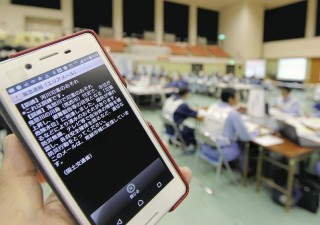Loading
Search
▼ Ministry Plans to Distribute Flood Information by Text Message
- Category:Other
The land ministry has started a project to send flood warnings via text message to the mobile phones of people in two cities, in the wake of large-scale floods caused by torrential rain in the Kanto and Tohoku regions in September last year.
The project began on Sept. 5 in Joso, Ibaraki Prefecture, and Ozu, Ehime Prefecture.
Within the next five years, the Land, Infrastructure, Transport and Tourism Ministry aims to widen areas where the service will be available to those along 109 river systems under the control of the central government.
According to the ministry, the rivers that are subject to the new warning system are the Kinugawa river in Joso and the Hijikawa river in Ozu.
The banks of the Kinugawa river overflowed when torrential rain hit the Kanto and Tohoku regions in September last year, while the Hijikawa river flooded when torrential rain fell in September 2011. Both times, large-scale flood damage occurred in areas along the rivers.
The ministry started the system of emergency warning text messages in the two cities because the city governments have made sufficient preparations, such as prior notification to residents.
With cooperation from major mobile phone service companies, the ministry will send emergency warning text messages en masse to smartphones and other types of mobile phones belonging to residents and visitors in the cities.
It will do so when the water levels of the two rivers exceed “risk levels” at which the city governments are required to issue evacuation instructions, or when floods actually occur.
The mechanism is the same as that of emergency earthquake warnings. Recipients do not need to change any settings on their phones, with the emergency warning messages to be automatically sent along with sound alarms.
The ministry’s Shimodate River Office, the Joso city government, the Ibaraki prefectural government and other entities conducted a drill in Joso on Sept. 5 to relay emergency information. It was based on scenarios including one in which the water level of the Kinugawa river had reached the 2.3-meter risk level and one in which the river overflowed its banks.
In addition to telephone alerts, emergency warning text messages were sent.
Mock data was transmitted to major mobile phone service companies from the ministry’s Kanto Regional Development Bureau.
Text messages were distributed to residents in the city and its suburbs, saying: “There is risk of floods due to the breaking of river banks. Please take proper disaster management actions, such as securing your safety.”
Shingo Satomura, chief of the Shimodate River Office, said after the drill:
“There could be situations in which residents are unable to clearly hear messages from the community wireless system or access websites displaying such information.
“We were able to confirm [in the drill] the effectiveness of the emergency warning text message system, which sends messages to individuals’ mobile phones.”
The project began on Sept. 5 in Joso, Ibaraki Prefecture, and Ozu, Ehime Prefecture.
Within the next five years, the Land, Infrastructure, Transport and Tourism Ministry aims to widen areas where the service will be available to those along 109 river systems under the control of the central government.
According to the ministry, the rivers that are subject to the new warning system are the Kinugawa river in Joso and the Hijikawa river in Ozu.
The banks of the Kinugawa river overflowed when torrential rain hit the Kanto and Tohoku regions in September last year, while the Hijikawa river flooded when torrential rain fell in September 2011. Both times, large-scale flood damage occurred in areas along the rivers.
The ministry started the system of emergency warning text messages in the two cities because the city governments have made sufficient preparations, such as prior notification to residents.
With cooperation from major mobile phone service companies, the ministry will send emergency warning text messages en masse to smartphones and other types of mobile phones belonging to residents and visitors in the cities.
It will do so when the water levels of the two rivers exceed “risk levels” at which the city governments are required to issue evacuation instructions, or when floods actually occur.
The mechanism is the same as that of emergency earthquake warnings. Recipients do not need to change any settings on their phones, with the emergency warning messages to be automatically sent along with sound alarms.
The ministry’s Shimodate River Office, the Joso city government, the Ibaraki prefectural government and other entities conducted a drill in Joso on Sept. 5 to relay emergency information. It was based on scenarios including one in which the water level of the Kinugawa river had reached the 2.3-meter risk level and one in which the river overflowed its banks.
In addition to telephone alerts, emergency warning text messages were sent.
Mock data was transmitted to major mobile phone service companies from the ministry’s Kanto Regional Development Bureau.
Text messages were distributed to residents in the city and its suburbs, saying: “There is risk of floods due to the breaking of river banks. Please take proper disaster management actions, such as securing your safety.”
Shingo Satomura, chief of the Shimodate River Office, said after the drill:
“There could be situations in which residents are unable to clearly hear messages from the community wireless system or access websites displaying such information.
“We were able to confirm [in the drill] the effectiveness of the emergency warning text message system, which sends messages to individuals’ mobile phones.”
- September 23, 2016
- Comment (0)
- Trackback(0)


